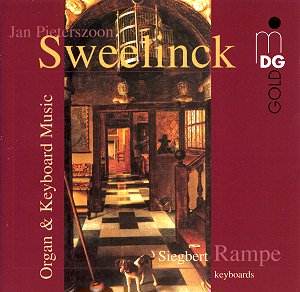Siegbert
Rampe is a well-known musicologist, editor and performer now
living in Cologne. Here he plays a nice cross-section of Sweelinck's
keyboard works on a fascinating set of instruments.
The
organ at Soest-Ostonnen was originally built by an anonymous
maker in around 1425, making it the oldest playable organ in
the world, (and you thought that was in Sion!). Later altered
by Bartholdus in 1586, Johann Patroclus Moller in 1721-2, Berhard
Dreymann in 1820, and finally restored by Rowan West in 2003,
it nevertheless contains 5 complete stops from 1586 or earlier,
4 of which from 1425. The remaining three stops all contain
15th or 16th century pipework. This is a remarkable survival,
which as yet has drawn little international attention.
Also
of interest, of course is the great Scherer organ of 1623-4
in Tangermünde. This is the largest surviving Hamburg school
organ of the pre-Schnitger generations. The astonishingly vocal
sound is the result of the extremely high lead-content pipework
throughout the organ. The stunning plenum sound, so mild, yet
so complex is quite unique, - but is the OberPositiff Zimbel
really supposed to be used in the plenum? Listen also to the
OberPositiff Zinck registration accompanied alone by the 16th
Principal of the Hauptwerk, astonishing!
Among
the stringed instruments, the Virginal deserves special mention
as it is the only surviving instrument made by the carilloneur
of the Oude Kerk during the time of Sweelinck. Artus Gheerdinck
was also responsible for tuning the organs. The 2 clavichords
are both copies, one of an Italian 4' instrument of around 1540,
the other of a Southern German clavichord of around 1670. The
harpsichord is the only preserved playable example of Ruckers
in its original state.
For
me, Rampe's playing is rather too fast and funky. He is clearly
a disciple of Ton Koopman, with whom he studied in Amsterdam.
Why does everything have to be so heavily ornamented, and the
touch so active? For me this music, especially the fantasias,
is far more monumental than Rampe would have us believe, the
Fantasia Chromatica is here especially hectic. I find also the
approach to the big Fantasias making crescendos from the Principals
to the plenum to be rather 'old hat'. The organs are quite beautiful
enough to play the whole work without having to change registration.
In general I find Rampe's overall approach suits the stringed
instruments better than the organs, his clavichord playing is
especially beautiful. The clavichords themselves are refreshingly
recorded, as if to reflect their extreme intimacy, without the
microphone being placed too close to the soundboard. Thus the
contrast between the huge plenum of Tangermünde, and the sound
of the clavichord is well reflected.
The
playing isn't my favourite then, but the instruments ensure
that this is worth hearing.
Chris Bragg

![]() Siegbert Rampe,
organs, clavichords, harpsichord, virginal
Siegbert Rampe,
organs, clavichords, harpsichord, virginal ![]() DABRINGHAUS UND GRIMM
MDG 341 1256-2 [79'01]
DABRINGHAUS UND GRIMM
MDG 341 1256-2 [79'01]





